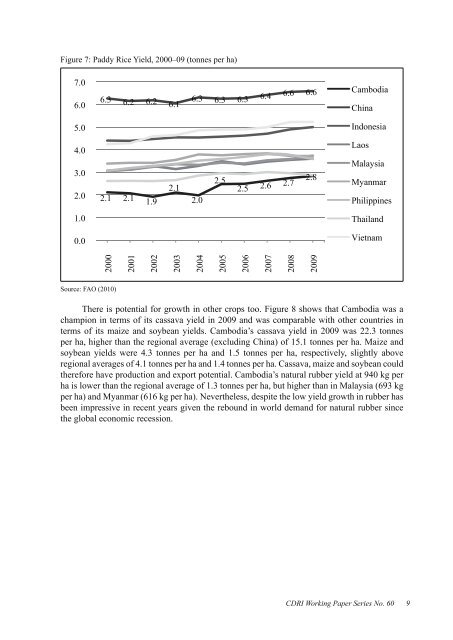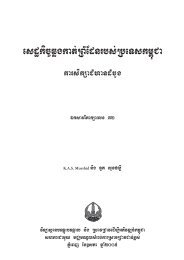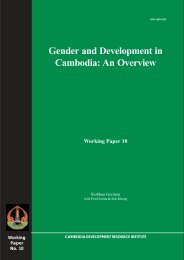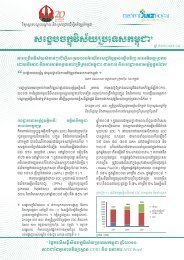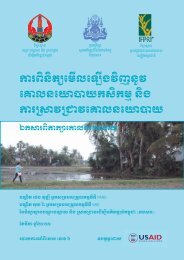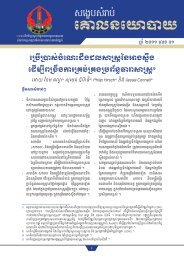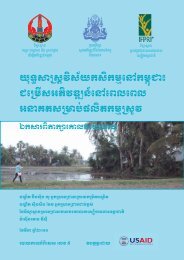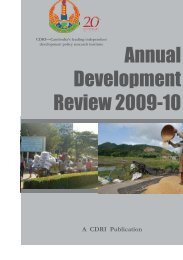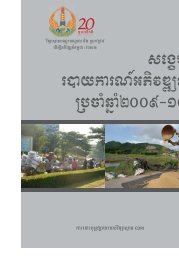Foreign Investment in Agriculture in Cambodia CDRI Working Paper ...
Foreign Investment in Agriculture in Cambodia CDRI Working Paper ...
Foreign Investment in Agriculture in Cambodia CDRI Working Paper ...
You also want an ePaper? Increase the reach of your titles
YUMPU automatically turns print PDFs into web optimized ePapers that Google loves.
Figure 7: Paddy Rice Yield, 2000–09 (tonnes per ha)<br />
7.0<br />
6.0<br />
5.0<br />
4.0<br />
3.0<br />
2.0<br />
1.0<br />
0.0<br />
6.3 6.2 6.2 6.1<br />
2.1 2.1 1.9<br />
2000<br />
Source: FAO (2010)<br />
2001<br />
2002<br />
2.1<br />
2003<br />
6.3 6.3 6.3 6.4 6.6 6.6<br />
2.0<br />
2004<br />
2.5<br />
2005<br />
2.5 2.6 2.7<br />
2006<br />
2007<br />
2008<br />
2.8<br />
2009<br />
<strong>Cambodia</strong><br />
Ch<strong>in</strong>a<br />
Indonesia<br />
Laos<br />
Malaysia<br />
Myanmar<br />
Philipp<strong>in</strong>es<br />
Thailand<br />
Vietnam<br />
There is potential for growth <strong>in</strong> other crops too. Figure 8 shows that <strong>Cambodia</strong> was a<br />
champion <strong>in</strong> terms of its cassava yield <strong>in</strong> 2009 and was comparable with other countries <strong>in</strong><br />
terms of its maize and soybean yields. <strong>Cambodia</strong>’s cassava yield <strong>in</strong> 2009 was 22.3 tonnes<br />
per ha, higher than the regional average (exclud<strong>in</strong>g Ch<strong>in</strong>a) of 15.1 tonnes per ha. Maize and<br />
soybean yields were 4.3 tonnes per ha and 1.5 tonnes per ha, respectively, slightly above<br />
regional averages of 4.1 tonnes per ha and 1.4 tonnes per ha. Cassava, maize and soybean could<br />
therefore have production and export potential. <strong>Cambodia</strong>’s natural rubber yield at 940 kg per<br />
ha is lower than the regional average of 1.3 tonnes per ha, but higher than <strong>in</strong> Malaysia (693 kg<br />
per ha) and Myanmar (616 kg per ha). Nevertheless, despite the low yield growth <strong>in</strong> rubber has<br />
been impressive <strong>in</strong> recent years given the rebound <strong>in</strong> world demand for natural rubber s<strong>in</strong>ce<br />
the global economic recession.<br />
<strong>CDRI</strong> Work<strong>in</strong>g <strong>Paper</strong> Series No. 60<br />
9


